(Because Spraying Pesticides Near Mr. Whiskers Is Not an Option)
Dealing with a pest-infested home is tough—but trying to get rid of those pests while keeping your pets safe? That’s a whole new level of challenge. Some people can just grab a can of spray or set out some poison baits and call it a day. Others ring up pest control as soon as they see a cockroach. But if you’re like me—a slightly obsessive, devoted pet parent—you pause and overthink every label, even something as simple as a floor cleaner.

You look at your fur babies, lounging on the furniture or snooping around the kitchen, and suddenly that chemical spray doesn’t feel worth it. Personally, I’ve chosen to live with cockroaches that act like they pay rent, just so I don’t put my cats at risk. It’s frustrating, it’s gross—but it doesn’t always have to be that way.
If you’re dealing with the same battle, you’re not alone. And no, you don’t have to choose between a clean home and a healthy pet. I’ve found real, safe ways to manage pests without risking my animals’ health.
Here are practical ways to get rid of pests while keeping your pets safe (because spraying pesticides near Mr. Whiskers is never an option!)
1. Seal and Secure Entry Points

The first step to keeping pests out is stopping them from getting in. Many infestations start because pests find easy access to your home through small gaps, holes, or openings you might not even notice. Sealing these entry points is your first line of defense—and it’s totally pet-safe.
- Install door sweeps.
- Seal cracks with silicone caulk.
- Use mesh covers for vents and drains.
- Repair any broken screens.
- Check under the sink for pest droppings.
2. Keep a Clean Home Without Harmful Chemicals
Pests are usually looking for food and water, so cleanliness is key. But many commercial cleaners are dangerous for pets—especially if they lick floors or surfaces. You can clean effectively without using harsh chemicals by switching to safer options that are still tough on grime.
- DIY cleaner: Mix equal parts white vinegar and water. Add lemon juice for scent.
- Pet-safe brands: Look for Seventh Generation, ECOS, or Aunt Fannie’s (check labels).
- Avoid: Bleach, ammonia, phenol-based disinfectants. They’re toxic to cats and dogs.

Also read: How to Pet-Proof Your Home Against Toxic Substances
3. Use Pet-Safe Pest Control Options
You don’t have to douse your house in poison to deal with bugs. There are effective alternatives that won’t put your pets at risk. These natural or low-toxicity options can help you control infestations without creating a toxic environment.
- Diatomaceous earth (food grade): Safe for pets, deadly for insects. Sprinkle under appliances and in cracks.
- Boric acid (use with caution): Keep it in inaccessible areas only—still safer than commercial sprays.
- Essential oil sprays: Mix water with peppermint oil, rosemary, or cedarwood (note: some oils are toxic to cats—research before use).
4. Pet-Safe Roach Bait Alternatives
Roach bait and poison traps are risky with pets around. Instead, make your own safe traps and deterrents. These DIY alternatives may not wipe out infestations overnight, but they help reduce the problem without risking your animal’s health.
- Sugar + baking soda mix: 50/50 in small shallow lids. Harmless to pets unless consumed in large amounts.
- Jar traps: Bait jars with coffee grounds or peanut butter. Smear the inside rim with petroleum jelly so they can’t escape.
5. Hire the Right Professionals

If you need help, choose a pest control service carefully. Not all exterminators use pet-safe methods, so it’s crucial to ask the right questions. Look for companies that understand your concern and have safer solutions.
- Look for companies that offer integrated pest management (IPM). They focus on prevention, not just chemicals.
- Ask specifically about pet-safe treatments. Get it in writing.
- Temporarily relocate pets during and after treatments if needed.
6. Prevention is Long-Term Protection
Pest control isn’t just a one-time fix—it’s a lifestyle. Long-term cleanliness and vigilance are key. Keeping your home uninviting to pests means fewer problems down the road.
- Store food in sealed containers.
- Clean pet food bowls after every meal.
- Don’t leave water sitting out overnight (except for pets).
- Empty trash daily.
- Vacuum regularly, especially under furniture and in corners.
7. Pet First Aid for Accidental Exposure

Even with precautions, accidents can happen. If your pet ingests something toxic or shows unusual symptoms after pest control treatments, quick action is critical. This is where having the right animal health products on hand can make all the difference. A basic pet first aid kit should include a few essentials to stabilize your pet before getting them to the vet.
- Activated charcoal (veterinary-grade): Can help absorb toxins if used immediately (ask your vet first).
- Hydrogen peroxide (3%): May be used to induce vomiting in dogs in some cases—only under vet guidance.
- Saline eye wash: For rinsing eyes in case of contact with sprays or dust.
- Pet-safe wipes: To clean paws and fur if exposed to substances.
- Important contacts: Keep the number of your vet and the local animal poison control center handy.
Always follow up with a vet, even if symptoms seem minor at first. It’s better to be overly cautious than risk a slow-developing reaction.

You shouldn’t have to choose between a clean home and your pet’s safety. By using smart prevention, safe cleaning, and thoughtful pest control alternatives, you can kick pests out without compromising your pet’s health. Stay consistent. Stay cautious. Your home can be both pest-free and pet-safe.
Author Bio: Carmina Natividad is a daytime writer for Abbey Labs, an Australian company offering reliable animal health solutions to support the well-being of pets and livestock. She loves creating easy-to-read content about animal care, veterinary tips, and the latest solutions that help animals live healthier lives.








